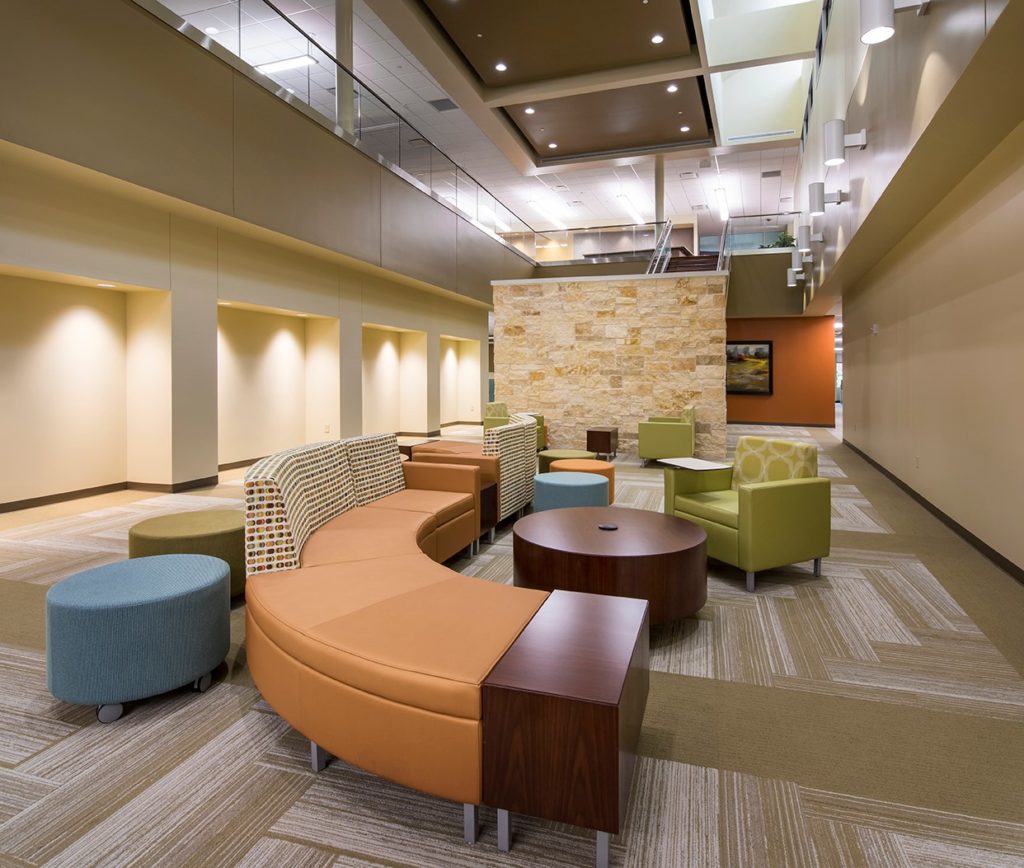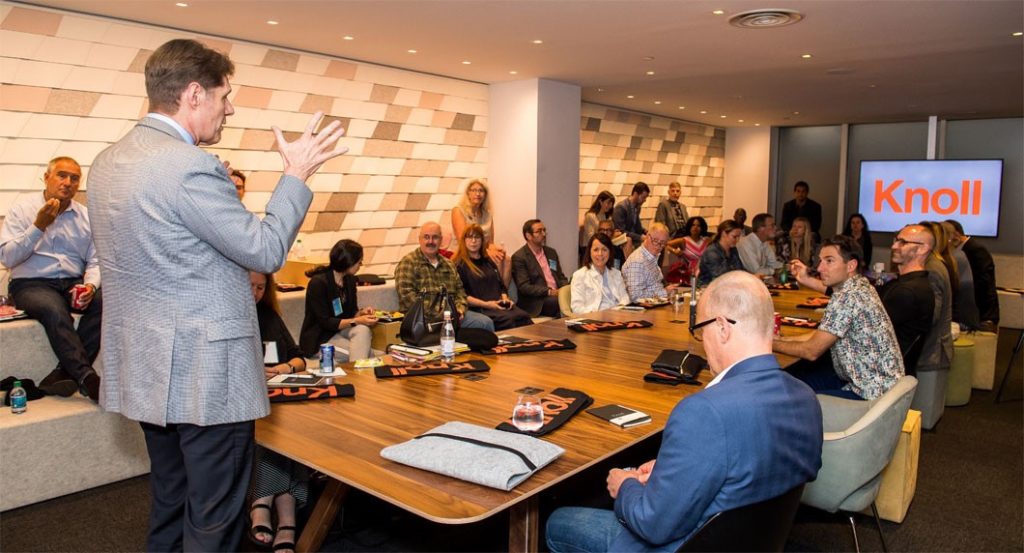Written by Amanda Jasper, Director of Corporate Communications at NewGround
Let’s face it: everyone wants to live and work in beautiful buildings. It all comes down to the way the interior is designed. That’s why our future relies on striking, innovative design to keep both consumers and employees happy in a refreshing work environment.
We sat down with Kylie Roth, Senior Director of Workplace Research at Knoll, and Kate Bechard, NCIDQ Senior Interior Designer at NewGround, to discuss how interior design shapes trends in the architecture of tomorrow.
DATCU Headquarters | Dallas, TX

Rooted in Research
Since 1938, Knoll has remained one of the leaders in the design industry when it comes to innovative design. To stay ahead of the game, Knoll constantly follows what’s happening in the industry.
“We are always researching what is happening, constantly working on current trends, and being forward-thinking,” said Kylie Roth, Senior Director of Workplace

Research at Knoll. “If it’s a trend now, then we should know about it five years in advance.”
Internally, Knoll has a small internal research group that uses a variety of qualitative and quantitative research strategies. Knoll also partners with outside experts and interviews top leaders of companies around the world to gain insight on what’s going on in the business and design world.
“Recently, we traveled North America to interview leaders at top companies about what their business and workplace challenges are and how they are impacted. It’s important to stay connected with what’s going on around our world,” said Kylie. “Then, we can educate companies about what new employees want, while still being cognizant about what veteran employees want,” said Kylie.

Knoll then collaborates with workplace leaders and designers based on the research they gather to incorporate new ideas and upcoming trends into their designs.
Staying relevant in a modern environment and embracing that relevancy is something businesses can capitalize on. Everyone wants to understand and keep up with what’s happening in different geographic regions around the world.
“When we talk to CEOs, if they can get a grasp on a plan for the next three to five years, they are feeling pretty good about their business,” said Kylie. “Businesses are now influenced by global trends that maybe 10 to 20 years ago were not necessarily impacting their business.
Design Trends
So what changes are impacting the design world? The more flexible, the better!

“The ever-evolving technology has the biggest impact on the design world,” said Kate Bechard, Senior Interior Designer at NewGround. “Aesthetically, we are also finding that people are seeking more connections from nature into their workspace. Currently, we are seeing more natural, organic schemes, with a large mix of light and dark wood tones, leathers, textures, and sometimes incorporating greenery or ‘living walls.’ Successful designs tend to blend some of the more recent trends like benching and collaboration spaces with the more traditional private offices to form customized solutions that will endure for years to come.”
“Right now, flexibility and addressing the challenges of the open office environment are our primary focus,” said Kylie. “Aesthetic trends will always change. We are in a very Scandinavian-moment with light woods and muted colors, and that will inevitably change, but providing design solutions for those core needs on how people work will always be relevant.

The biggest change in design has been individual private offices. There is more need for a flexible work environment, with easy collaboration and comfort. People are working in open spaces for a large amount of time instead of individual offices, and the design should reflect their needs for that space.
“Modular configurations are important for workstations. Many of our new designs include a wide variety of types of seating, fitting all ages and all demographics. Mixed seating, mixed table use, and mixed formal and informal areas are being implemented in designs,” said Kate.
People also seek privacy in different ways that work best for them.
“The need for privacy and acoustics in open office spaces is a huge challenge. Noise is still the number one challenge many clients face,” said Kylie. “We like to think of the individual: everyone has different needs and preferences for their workspace.”
The Power of Technology
“Picture this: in the caveman days, people would huddle around a fire to stay alive—but now, they are huddling around power outlets!” said Kylie.
Technology has been woven into our lives, so keeping the workspace flexible enough using plug-ins for chairs, counters, and tables is beneficial for most clients across multiple industries.

“We try to steer our clients away from building a piece of technology to fit into a wall that isn’t a modular wall,” said Kate. “We need to always plan and make versatile designs that can be easily changed.”
Could wireless connections dominate our design future?
“I don’t doubt that eventually, we will have completely wireless power,” said Kylie. “That will change how people work, ultimately affecting how we design everything.”
You must be willing to evolve and change with advancing technology. If your business is evolving, then your space also needs to evolve.
Managing Change
Helping people adapt to their new, flexible environments is crucial for success.
“Having multiple conversations with the client and understanding their vision and needs will give them all of the tools up front to effectively utilize the design changes,” said Kate. “You want people to be comfortable in their new space by providing workplace training to help people adapt. When employees feel comfortable and their workspace allows them to be productive and work efficiently, they are happier and work more productively.”
Give people a voice to feel engaged and cared about! “Change done to you is very different than change done by you,” said Kylie. “The bigger companies get, the harder it is to zero in on what your employees want. You can never overcommunicate when it comes to workplace change.”
Design with humans in mind for that moment in time, fully knowing some design changes may work and not work.
“Change is a big deal—even the word itself tends to make people wary. Engaging with an experienced consultant is one step in the right direction,” said Kate. “NewGround has the tools to help clients see the return on their investment when changing their way of business. Engage with your employees in the beginning, be transparent about change, and share your plan with employees before any rumors start. Lastly, get all executives and managers on board to carry their plans down to the front. What works for one person doesn’t always work for another. People like to know that they have a voice and have been heard.”
Be willing to take risks when it comes to interior design trends, and don’t let fear hold you back.
“I don’t think we can 100% design for the future, but working with the client to understand their business goals only helps NewGround lead the client into a workspace that will allow them to remain current and progressive,” said Kate. “Showing the client how efficient their new space can be will help them realize that change is needed for their business to grow. Change is not always easy, but at NewGround, we pride ourselves on making the transition seamless.”
“No one can fully predict the future, but we can do our best to help clients prepare for it,” said Kylie.